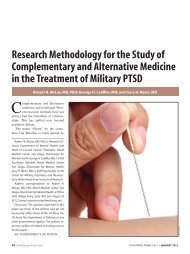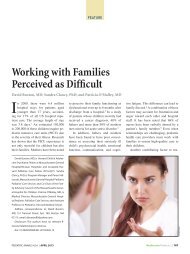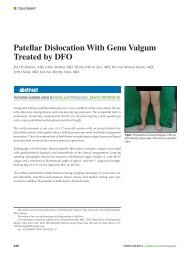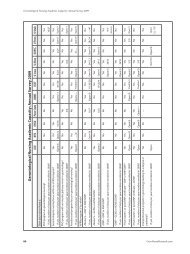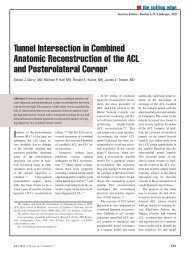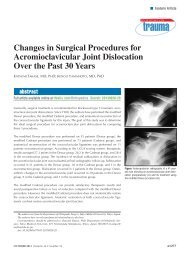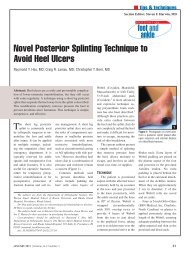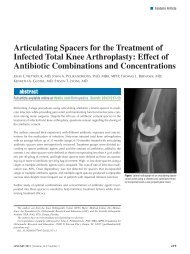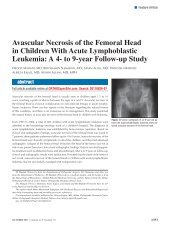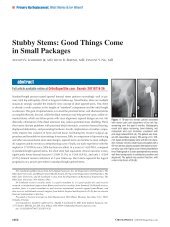Additional Thoughts on Orthopedic Residency and ... - Healio
Additional Thoughts on Orthopedic Residency and ... - Healio
Additional Thoughts on Orthopedic Residency and ... - Healio
Create successful ePaper yourself
Turn your PDF publications into a flip-book with our unique Google optimized e-Paper software.
■ guest editorial<br />
<str<strong>on</strong>g>Additi<strong>on</strong>al</str<strong>on</strong>g> <str<strong>on</strong>g>Thoughts</str<strong>on</strong>g> <strong>on</strong> <strong>Orthopedic</strong><br />
<strong>Residency</strong> <strong>and</strong> Fellowships<br />
Augusto Sarmiento, MD<br />
In the guest editorial “The Educati<strong>on</strong> of <strong>Orthopedic</strong> Residents<br />
<strong>and</strong> Fellows” (http://www.orthosupersite.com/view.<br />
aspx?rid=60341) in the February 2010 issue of ORTHOPE-<br />
DICS, my co-author <strong>and</strong> I expressed c<strong>on</strong>cerns over the perceived<br />
impact of the increasing popularity of fellowships <strong>on</strong> residency<br />
programs, while making suggesti<strong>on</strong>s <strong>on</strong> how to prevent harmful,<br />
unintended c<strong>on</strong>sequences.<br />
In that article, we attempted to study the genesis of fellowships,<br />
<strong>and</strong> particularly their rapid spread. We speculated that the<br />
initial interest in them was the residents’ desire to overcome perceived<br />
deficiencies in specific areas of the discipline that may<br />
have resulted from the proliferati<strong>on</strong> of subspecialties services<br />
that brought about a shortening in the length of rotati<strong>on</strong>s over the<br />
5 years of structured educati<strong>on</strong>. 1<br />
I had l<strong>on</strong>g suspected that such an explanati<strong>on</strong> was not necessarily<br />
accurate, since within a short time most residents pursuing<br />
an additi<strong>on</strong>al year of fellowship were not choosing training in<br />
areas of perceived deficiencies but in areas where greater opportunities<br />
for lucrative practices were more likely to exist.<br />
The rapid growth in interest in fellowships, however, came<br />
with obstacles for many since saturati<strong>on</strong> with newly graduated<br />
fellowship-trained orthopedists wishing to limit their practice to<br />
the subspecialty of their fellowships is already taking place in<br />
many cities. The number of super-specialized orthopedists that<br />
a given community can afford to have is based <strong>on</strong> the size of<br />
the populati<strong>on</strong> in the area to be served. A city of any size may<br />
provide an adequate number of patients to satisfy the emoti<strong>on</strong>al,<br />
professi<strong>on</strong>al, <strong>and</strong> financial needs of <strong>on</strong>ly a certain number of<br />
Dr Sarmiento is from the Department of <strong>Orthopedic</strong>s, University of Miami<br />
Medical School, Florida.<br />
Dr Sarmiento has no relevant fi nancial relati<strong>on</strong>ships to disclose.<br />
doi: 10.3928/01477447-20100826-01<br />
such specialized surge<strong>on</strong>s. If their numbers exceed those criteria,<br />
they begin either to increase the indicati<strong>on</strong>s for surgery<br />
(which has a limit) or to broaden the scope of their practices<br />
into areas where they had previously felt insufficiently trained<br />
to perform well.<br />
As the number of fellows in orthopedic programs affiliated<br />
with medical schools has increased exp<strong>on</strong>entially in recent years,<br />
Residents should be the <strong>on</strong>es performing<br />
the procedure, while fellows should serve<br />
as assistants.<br />
several programs now have with more fellows than residents.<br />
This has resulted in unhappiness am<strong>on</strong>g residents who perceive,<br />
<strong>and</strong> rightly so, that surgical material they expected to serve as<br />
opportunities to enhance their surgical skills is now, to a high<br />
degree, the fellows’ territory.<br />
According to some, the underlying factor explaining the<br />
growth in fellowships is the realizati<strong>on</strong> that the structured 5-year<br />
period of residency is not sufficiently l<strong>on</strong>g <strong>and</strong> therefore should<br />
be extended. I disagree with this premise. What is needed is not<br />
additi<strong>on</strong>al time but a reassessment of the current situating <strong>and</strong><br />
the placement of fellowships in the proper perspective. The more<br />
fellows added to residency programs, the more severe the problem<br />
will become, aggravating the existing unhappiness am<strong>on</strong>g<br />
the residents. This unhappiness may so<strong>on</strong> turn into anger <strong>and</strong><br />
dem<strong>and</strong>s for a resoluti<strong>on</strong> of the problem.<br />
Since frustrati<strong>on</strong> with the failure to obtain sufficient surgical<br />
experience in several areas is a major cause of the dilemma,<br />
it is likely that in the near future, 1 year of fellowship, which<br />
712 ORTHOPEDICS | ORTHOSuperSite.com
■ guest editorial<br />
may have corrected the deficiency in 1 specific area, will not be<br />
enough, <strong>and</strong> another year will be sought for another area where a<br />
similar problem existed.<br />
Our guest editorial suggested that it is imperative for directors<br />
of residency programs to give the highest priority to resident<br />
educati<strong>on</strong>, not to fellowship educati<strong>on</strong>. Resident educati<strong>on</strong><br />
is their first resp<strong>on</strong>sibility, <strong>and</strong> the emphasis <strong>on</strong> fellowships<br />
should be tempered. We proposed that in those instances when<br />
surgery is to be performed by people other than the faculty, the<br />
residents should be the <strong>on</strong>es performing the procedure, while the<br />
fellows, seeking additi<strong>on</strong>al exposure to a given subject, should<br />
serve as assistants, unless the volume of surgical material is so<br />
large that both groups can be appropriately accommodated. This<br />
suggesti<strong>on</strong>, “as illogical as it may appear to many, should not<br />
be dismissed too cavalierly,” since “the fellows we are c<strong>on</strong>sidering<br />
under this scenario will be individuals who, according to our<br />
suggested plan, would have received during their residency sufficient<br />
exposure to their subsequently chosen subspecialty.”<br />
It is my suspici<strong>on</strong> that we had not sufficiently studied the issue<br />
at h<strong>and</strong> when we wrote the guest editorial, <strong>and</strong> this prompted my<br />
desire to look in greater depth at the growing trend of pharmaceutical<br />
<strong>and</strong> implant manufacturing companies subsidizing orthopedic<br />
fellowships. This feature is not being openly acknowledged<br />
by directors of residency programs but has not escaped<br />
residents, particularly those who had failed to receive acceptance<br />
for fellowship training.<br />
The fact that the subsidizing of fellowships by industry is becoming<br />
widespread suggests that the same will so<strong>on</strong> happen to<br />
fellowships not affiliated with medical schools, if it is not already<br />
the case. Community surge<strong>on</strong>s with busy <strong>and</strong> successful private<br />
practices have fellows, <strong>and</strong> others wish to have them. It is logical<br />
to anticipate that some of these practiti<strong>on</strong>ers, aware that the<br />
financing of fellowships can be obtained from industry, will seek<br />
approval of their own programs from those resp<strong>on</strong>sible for their<br />
accreditati<strong>on</strong>. They could justify their requests based <strong>on</strong> the fact<br />
that they have a large volume of patients <strong>and</strong> will be able to add<br />
didactic c<strong>on</strong>ferences <strong>and</strong> research activities to their fellows.<br />
I recently learned from a young orthopedist that his fellowship<br />
had been subsidized by a certain implant manufacturing<br />
company, <strong>and</strong>, in additi<strong>on</strong>, the expenses incurred by attending 2<br />
major h<strong>and</strong>s-<strong>on</strong> courses held in distant cities had been covered<br />
by another industrial c<strong>on</strong>cern.<br />
Although the issue of industry subsidizing orthopedic fellowships<br />
has not as yet reached critical levels, I suspect it will reach<br />
the point where official interventi<strong>on</strong> by the appropriate accrediting<br />
bodies will become urgent.<br />
Industry’s reach has proven powerful <strong>and</strong> will c<strong>on</strong>tinue to<br />
grow l<strong>on</strong>ger <strong>and</strong> str<strong>on</strong>ger. To assume this not to be the case is<br />
dangerous naïveté. 2 Industry, we must recognize, is not interested<br />
in educati<strong>on</strong> for its own sake, but because by subsidizing<br />
it they exp<strong>on</strong>entially increase the number of physicians who in a<br />
quid pro quo fashi<strong>on</strong> will use the products manufactured by their<br />
generous sp<strong>on</strong>sors <strong>and</strong>/or serve their marketing agenda. 2<br />
There is no l<strong>on</strong>ger room for complacency <strong>and</strong> pusillanimous<br />
resp<strong>on</strong>ses. We owe future generati<strong>on</strong>s a major effort to solve a<br />
situati<strong>on</strong> rich with potentially serious <strong>and</strong> unanticipated c<strong>on</strong>sequences.<br />
REFERENCES<br />
1. Sarmiento A. Subspecializati<strong>on</strong> in orthopaedics. Has it been all for the<br />
better? J B<strong>on</strong>e Joint Surg Am. 2003; 85(2):369-373.<br />
2. Sarmiento A. The relati<strong>on</strong>ship between orthopaedics <strong>and</strong> industry must<br />
be reformed. Clin Orthop Relat Res. 2003; (412):38-44.<br />
OCTOBER 2010 | Volume 33 • Number 10 713




